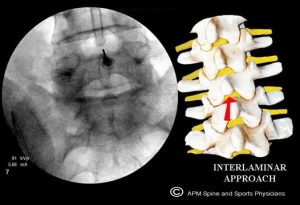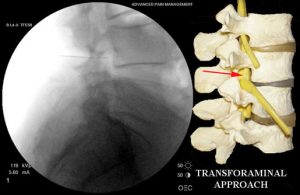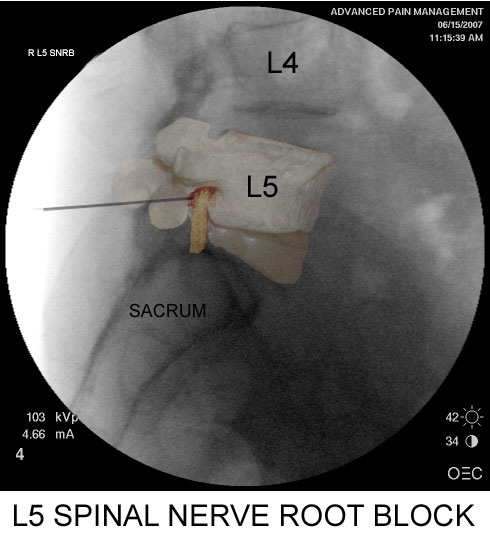
What are epidural steroid injections?
Epidural steroid injections (ESIs) are therapeutic spinal injection procedures that are part of the first or second line treatment for herniated discs, sciatica and spinal stenosis. When oral steroids, rest and physical therapy are not effective in relieving pain due to these conditions then ESIs are the next best step. Sometimes, we can successfully treat sciatic pain with one ESI but occasionally you may need up to 3-4 ESI’s to address more challenging spinal issues.
ESIs can be performed in the neck, mid-back and lower back. These injections are performed by placing a small spinal needle under x-ray guidance into the epidural space close to the problem area and then injecting x-ray contrast dye to confirm optimal flow. Once the correct needle placement is confirmed then a mixture consisting of a steroid and a local anesthetic are injected into the epidural space. This is the space just behind the nerves, spinal fluid, and spinal cord. This mixture is useful to reduce inflammation, swelling, numbness and pain from inflamed nerve roots or herniated discs. It is also helpful in treating spinal stenosis.
It is very important to keep in mind that we do inject x-ray contrast “dye” with all ESI’s and selective nerve root blocks. If you have an allergy to x-ray contrast, iodine or shellfish please notify us several days prior to your procedure as you will need to get the Radin Prep prescribed for you. This prep consists of Benadryl and Prednisone taken at specific times prior to your scheduled procedure appointment. Also, please note that we do require lab work to be checked prior to cervical ESI’s. This must be done within a week of your scheduled ESI. Please contact our office for the lab order so that you can get these labs done in a timely manner so that we can review your results prior to your arrival for your cervical ESI.
What are the different types of epidural steroid injections?
These 3 approaches describe the path we take to deliver the medication as close as possible to your pain generator.
- Caudal ESI:this injection is placed through a small opening (sacral canal) just above the tailbone. It is a very safe injection with very little risk and is most effective with central disc herniations at L5-S1 and L4-5 as well as spinal stenosis at these levels.
- Interlaminar ESI:the injection is usually midline and placed directly between two vertebrae (similar to the approach a woman undergoes during labor for epidural anesthesia). This approach is used less often as it delivers the steroid and lidocaine mixture to the
 space behind the disc and is felt to be an older less direct approach. For this reason, this approach is used less often in the lower back but more often in the mid back and neck.
space behind the disc and is felt to be an older less direct approach. For this reason, this approach is used less often in the lower back but more often in the mid back and neck. - Transforaminal ESI or retro-discal ESI: with this ESI approach the spinal needle is placed into the foramina or opening for the nerve root on the same side of the spine as your pain and at the same level. Using X-ray guidance to steer the needle the Transforaminal approach directs the needle above the exiting nerve root and the retro-discal approach directs the needle below the exiting nerve and directly beh
 ind the disc at the affected lumbar level. These 2 approaches are felt to be the most direct way to deliver the medication to the problem area. When done correctly, they can work quickly to alleviate pain and are generally very safe. While these approaches are considered therapeutic they can also provide diagnostic information and when this is done we call it a selective nerve root block. Transforaminal ESIs can be performed in the neck, mid-back and lower back.
ind the disc at the affected lumbar level. These 2 approaches are felt to be the most direct way to deliver the medication to the problem area. When done correctly, they can work quickly to alleviate pain and are generally very safe. While these approaches are considered therapeutic they can also provide diagnostic information and when this is done we call it a selective nerve root block. Transforaminal ESIs can be performed in the neck, mid-back and lower back.
Selective Nerve Root Blocks
What are selective nerve root blocks?
 A selective nerve root block can be done in the neck, mid-back and low back. It is purely a diagnostic spinal injection procedure in which anesthetic is placed on a specific nerve root of the spine to help identify the exact source of leg or arm pain. The injection may also contain a steroid to decrease inflammation and pain. The injection is similar to a transforaminal epidural steroid injection, but in a selective nerve root block there is no attempt to have the medication enter the epidural space. Rather, the aim is strictly to cover the offending nerve root and block the nerve for approximately 4 hours.
A selective nerve root block can be done in the neck, mid-back and low back. It is purely a diagnostic spinal injection procedure in which anesthetic is placed on a specific nerve root of the spine to help identify the exact source of leg or arm pain. The injection may also contain a steroid to decrease inflammation and pain. The injection is similar to a transforaminal epidural steroid injection, but in a selective nerve root block there is no attempt to have the medication enter the epidural space. Rather, the aim is strictly to cover the offending nerve root and block the nerve for approximately 4 hours.
How are selective nerve root blocks and epidural steroid injections (ESIs) done?
All of these procedures are usually done with the patient lying on his or her stomach. The area to be injected is thoroughly prepped with antiseptic solution before the injection is performed. After the skin has been numbed with local anesthetic, a small spinal needle is inserted under x-ray guidance to the appropriate position within the spine.
For selective nerve root blocks and the transforaminal approach for an epidural steroid injection, the final needle position is just above the target nerve root.
In the caudal approach for an epidural steroid injection, the needle is passed through a small opening (sacral hiatus) just above the tailbone.
With the interlaminar approach of an epidural steroid injection, the needle is passed between two vertebrae, usually midline. Contrast dye is injected to confirm proper needle position.
The medication is then injected. The patient’s vital signs are closely monitored during the procedure, which takes about 15 to 30 minutes. After the injection, the patient is taken to the post-procedure area for continued monitoring. Once, appropriate post block instructions are given to the patient and post procedure vital signs are normal then the patient is escorted to their car and discharged with a driver. Having someone drive you home after an injection is VERY IMPORTANT following all of these procedures because you may experience transient numbness in your leg and this could make it unsafe for you to drive for approximately 4 hours after the procedure.
What is actually injected?
The injection usually consists of a mixture of a local anesthetic (e.g., Marcaine®, Lidocaine) and the steroid injection (e.g., Dexamethasone).
Is the procedure painful?
Not usually. Most patients say it is about as painful as a routine blood test. Typically, patients report feeling pressure in their back and or leg during the injection. We want our patients awake for these procedures as we want to make sure that the spinal needle is not too close to the existing nerve.
What should I expect after the procedure?
Since a local anesthetic is placed around a nerve root or epidural space, you may experience a period of numbness in that region or limb for 4 to 8 hours. The steroid medication may begin working anywhere from 6 hours to 3 days after the injection. Some individuals do experience a period of soreness 1 to 2 days after the injection. An application of ice may help during this period. Within one to five days, you may start noticing significant pain relief.
What should I do after the procedure?
After the procedure, you should have someone drive you home. It is advised that patients minimize their activity and take it easy for a day or so after the procedure. If there is soreness at the injection site, you can apply ice to the area. If you experience redness or swelling at the injections site or if you have persistent pain or numbness following the procedure please notify our office.
How soon can I return to work?
The day after the procedure, you can perform normal activities as long as they are not uncomfortable.
How many Epidural Steroid Injections should I have?
We generally do not perform more than three- four injections within a 12-month period. Very frequent injections may increase the likelihood of side effects from the steroid.
Are there any risks with this procedure?
This is considered a very safe procedure. However, as with any procedure, there are risks and possible side effects or complications.
The complications from the selective nerve root blocks and epidural steroid injection include:
- Pain at the injection site – common
- Worsening of symptoms – occasional
- Allergic reaction- rare
- Infection – rare
- Bleeding – rare
- Serious nerve or spinal cord injury – extremely rare
Other side effects are generally related to the steroid medication and may include:
- Fluid retention – uncommon
- Weight gain – uncommon
- Elevated blood pressure – uncommon
- Mood swings – rare
- Insomnia – rare
- Menstrual irregularities
- Suppression of the body’s own natural production of cortisone – rare
Can I have this procedure if I am on Coumadin®?
No not usually. Sometimes if it is not safe to take you off of a blood thinner we can perform some spinal injections using a very small gauge needle. This is best decided on a case by case basis. In general though, you should discuss your need for the procedure and the risks of bleeding if you are currently taking blood-thinning medication such as Coumadin® or Plavix®. You may be asked to temporarily stop your blood-thinning medication, but do not do so without discussing this with your doctor.
Who should not receive a selective nerve root block or epidural steroid injection?
You should not undergo a selective nerve root block or epidural steroid injection if:
- You are prone to excessive bleeding or you are taking anticoagulant (blood thinning) medication.
- You are pregnant.
- Your back pain has been diagnosed as being the result of an infection or malignancy.
- There is any systemic bacterial infection or local skin infection near the injection site.









